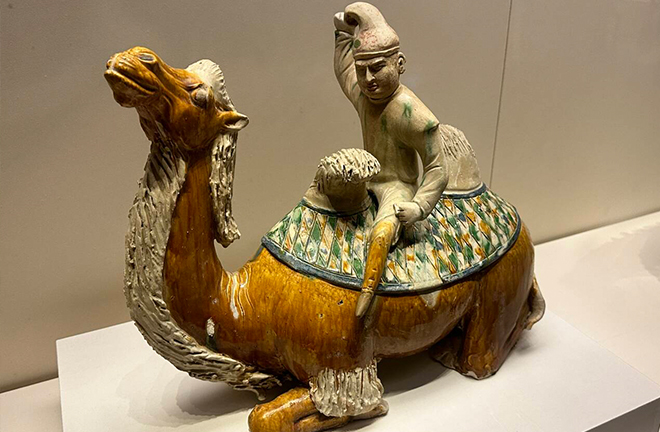Silk Road civilization extends beyond West-centrism

Pictured above is a Sancai-glazed pottery Hu figure on camelback dating to the Tang Dynasty, displayed at the National Museum of China in Beijing. Hu or foreign elements were introduced to China via the ancient Silk Road. Photo: Ren Guanhong/CSST
Since its publication in 2015, The Silk Roads: A New History of the World by Peter Frankopan, a professor of global history and director of the Byzantine Research Center at the University of Oxford, has garnered widespread international acclaim. Media outlets from around the world have praised the book for challenging the traditionally West-centric view of history. Instead, it presents a global history focusing on the East, transcending ideological boundaries and restoring the prosperity of trade and civilizational exchanges along the ancient Silk Road that originated in China. In a recent interview with CSST, Frankopan discussed the profound influence of Silk Road civilization on human history.
Condensed world history
In Frankopan’s opinion, history is complex and nuanced, demanding a huge canvas, considerable expertise, and patience to depict. “One needs to be able to read many languages, but also to understand what the intentions of authors writing in the past or in different regions were trying to say and to whom. In fact, it includes almost 3,000 references, and in the book, I also kept switching perspectives to restore the long history of the ancient Silk Road,” Frankopan said.
“Based on a lot of research and analysis, I came to the conclusion that the Silk Road dominated world history before the rise of Western hegemony in the 16th century. Even after the 16th century, the Silk Road still deeply influenced world civilization. It is valuable heritage of human civilization, which belongs not only to China, but also to the world,” Frankopan continued.
As Frankopan noted, the history of the Silk Road can be described as a condensed history of the world. It bore witness to the connections between peoples and civilizations which were indeed intense, and created a world that was deeply inter-connected. A key route connecting the East and the West, the Silk Road depicts world history more than 2,000 years ago. As a series of networks that facilitated exchanges, it constituted the “central nervous system” of the world.
“Many scholars still study the Silk Road’s trade and cultural exchanges between the Han Dynasty and Rome. The Han thrived at a time when the Roman Empire was also at its peak, controlling most of Europe, North Africa, and the Middle East. There were exchanges of many things—not least horses, leather, textiles, and meat from nomadic peoples living on the steppe,” Frankopan added.
Established world center
As Frankopan pointed out, mainstream academia in Europe has long regarded the Mediterranean Sea as the cradle of human civilization. However, he argues that the true “center of the globe” is not the sea that separates Europe from North Africa, but rather the heart of Asia.
“Based on a large number of material analysis, I have always believed that the hinterland of Asia crossed by the ancient Silk Road is the cradle of human civilization, and the Silk Road had been the world center,” Frankopan said.
In fact, many cultural scholars believe that this is not only where human civilization originated, but also the birthplace of humanity itself. “There were Yellow and Yangtze, Tigris, Euphrates, Indus, and Mekong Rivers in the region. The earliest texts of writings appeared; the first cities grew up. This is where trade and exchanges flourished, and that can often link to further population growth as demand for labor rises. When that happens, states can start to form,” Frankopan added.
Diversity matters
Frankopan further emphasized that the subjective way some Western scholars write about history reveals a deep-rooted cultural bias, which wrongly considers that one culture is better than another, or contributes more. It encourages nationalist sentiments that serve political goals, rather than the objective truths of the historian: “This is why I also do not like to talk about how a civilization of a nation improved those of other peoples; as to do so is to betray the science, history, and facts.”
Artifacts from the Silk Road initially piqued the interest of scholars, leading many Western archaeologists to transport these cultural objects to Britain and other parts of Europe. All empires engage in similar practices when they expand: appropriating the property and heritage of other peoples, Frankopan said.
“Today, many objects are finally returning home—often because generous and wealthy buyers in China acquire them from galleries and in auctions, and often donate these to national collections. That is part of the rich cycle of history, and one that makes me happy,” Frankopan said.
The history of the Silk Road demonstrates that closer and more frequent contact can stimulate innovation and foster collaboration. “In today’s world, we should celebrate diversities and not force each other into models that are standardized. What made societies rich, both economically and culturally, were outside influences, new ideas and openness. Some of the causes of great misfortune in history include single-mindedness, resistance to change, and insistence on standardization. That approach proved very costly over time,” Frankopan concluded.
Edited by CHEN MIRONG
